Recreation Program and Evaluation Plan: A Detailed Case Study
VerifiedAdded on 2023/06/03
|8
|2224
|56
Report
AI Summary
This report provides a comprehensive recreation program and evaluation plan tailored for university students, addressing the constraints of extracurricular activities and aiming to promote healthy physical and psychological development. The plan includes a visual planning model that considers time consumption, strenuous activities, and unhealthy competitiveness. It proposes solutions such as intra-college musical nights, chess competitions, and community engagement programs to foster bonding, intelligence, and social responsibility. The evaluation criteria are clearly identified, and questionnaires are designed to assess both short-term and long-term program outcomes. The report concludes by emphasizing the importance of reducing injury and depression among students through less time-consuming and financially burdensome activities, supported by relevant academic references and a detailed analysis of the program's effectiveness.
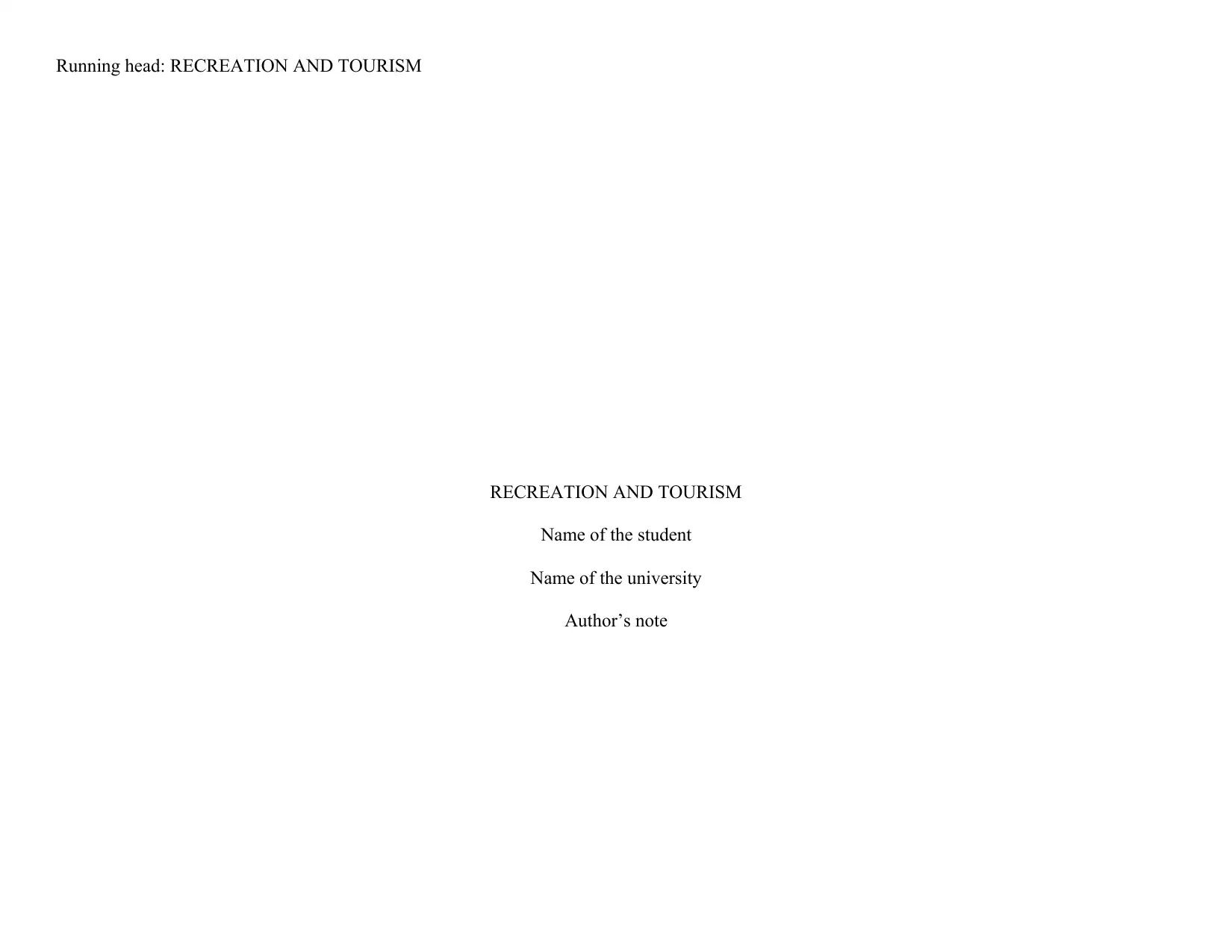
Running head: RECREATION AND TOURISM
RECREATION AND TOURISM
Name of the student
Name of the university
Author’s note
RECREATION AND TOURISM
Name of the student
Name of the university
Author’s note
Paraphrase This Document
Need a fresh take? Get an instant paraphrase of this document with our AI Paraphraser
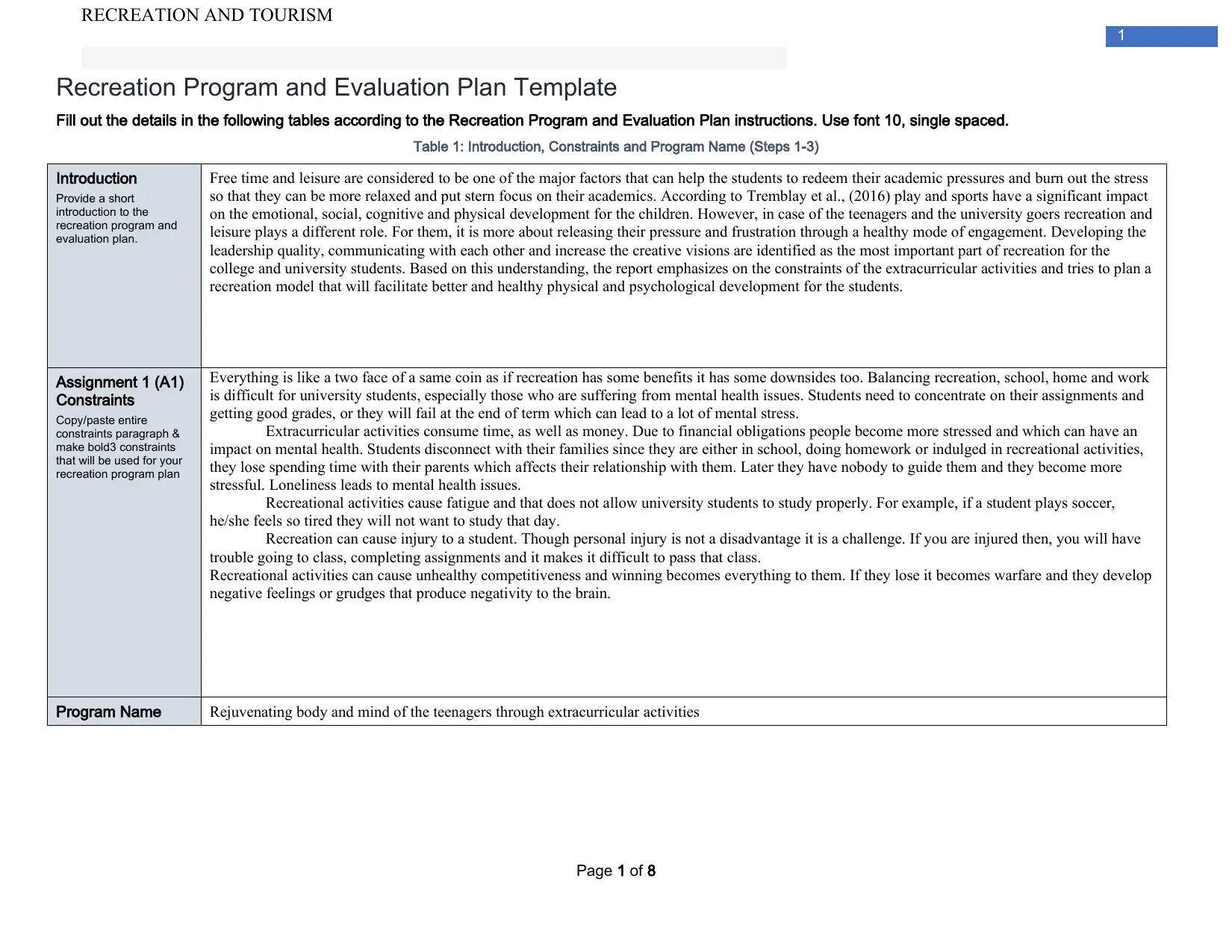
1
RECREATION AND TOURISM
Recreation Program and Evaluation Plan Template
Fill out the details in the following tables according to the Recreation Program and Evaluation Plan instructions. Use font 10, single spaced.
Table 1: Introduction, Constraints and Program Name (Steps 1-3)
Introduction
Provide a short
introduction to the
recreation program and
evaluation plan.
Free time and leisure are considered to be one of the major factors that can help the students to redeem their academic pressures and burn out the stress
so that they can be more relaxed and put stern focus on their academics. According to Tremblay et al., (2016) play and sports have a significant impact
on the emotional, social, cognitive and physical development for the children. However, in case of the teenagers and the university goers recreation and
leisure plays a different role. For them, it is more about releasing their pressure and frustration through a healthy mode of engagement. Developing the
leadership quality, communicating with each other and increase the creative visions are identified as the most important part of recreation for the
college and university students. Based on this understanding, the report emphasizes on the constraints of the extracurricular activities and tries to plan a
recreation model that will facilitate better and healthy physical and psychological development for the students.
Assignment 1 (A1)
Constraints
Copy/paste entire
constraints paragraph &
make bold3 constraints
that will be used for your
recreation program plan
Everything is like a two face of a same coin as if recreation has some benefits it has some downsides too. Balancing recreation, school, home and work
is difficult for university students, especially those who are suffering from mental health issues. Students need to concentrate on their assignments and
getting good grades, or they will fail at the end of term which can lead to a lot of mental stress.
Extracurricular activities consume time, as well as money. Due to financial obligations people become more stressed and which can have an
impact on mental health. Students disconnect with their families since they are either in school, doing homework or indulged in recreational activities,
they lose spending time with their parents which affects their relationship with them. Later they have nobody to guide them and they become more
stressful. Loneliness leads to mental health issues.
Recreational activities cause fatigue and that does not allow university students to study properly. For example, if a student plays soccer,
he/she feels so tired they will not want to study that day.
Recreation can cause injury to a student. Though personal injury is not a disadvantage it is a challenge. If you are injured then, you will have
trouble going to class, completing assignments and it makes it difficult to pass that class.
Recreational activities can cause unhealthy competitiveness and winning becomes everything to them. If they lose it becomes warfare and they develop
negative feelings or grudges that produce negativity to the brain.
Program Name Rejuvenating body and mind of the teenagers through extracurricular activities
Page 1 of 8
RECREATION AND TOURISM
Recreation Program and Evaluation Plan Template
Fill out the details in the following tables according to the Recreation Program and Evaluation Plan instructions. Use font 10, single spaced.
Table 1: Introduction, Constraints and Program Name (Steps 1-3)
Introduction
Provide a short
introduction to the
recreation program and
evaluation plan.
Free time and leisure are considered to be one of the major factors that can help the students to redeem their academic pressures and burn out the stress
so that they can be more relaxed and put stern focus on their academics. According to Tremblay et al., (2016) play and sports have a significant impact
on the emotional, social, cognitive and physical development for the children. However, in case of the teenagers and the university goers recreation and
leisure plays a different role. For them, it is more about releasing their pressure and frustration through a healthy mode of engagement. Developing the
leadership quality, communicating with each other and increase the creative visions are identified as the most important part of recreation for the
college and university students. Based on this understanding, the report emphasizes on the constraints of the extracurricular activities and tries to plan a
recreation model that will facilitate better and healthy physical and psychological development for the students.
Assignment 1 (A1)
Constraints
Copy/paste entire
constraints paragraph &
make bold3 constraints
that will be used for your
recreation program plan
Everything is like a two face of a same coin as if recreation has some benefits it has some downsides too. Balancing recreation, school, home and work
is difficult for university students, especially those who are suffering from mental health issues. Students need to concentrate on their assignments and
getting good grades, or they will fail at the end of term which can lead to a lot of mental stress.
Extracurricular activities consume time, as well as money. Due to financial obligations people become more stressed and which can have an
impact on mental health. Students disconnect with their families since they are either in school, doing homework or indulged in recreational activities,
they lose spending time with their parents which affects their relationship with them. Later they have nobody to guide them and they become more
stressful. Loneliness leads to mental health issues.
Recreational activities cause fatigue and that does not allow university students to study properly. For example, if a student plays soccer,
he/she feels so tired they will not want to study that day.
Recreation can cause injury to a student. Though personal injury is not a disadvantage it is a challenge. If you are injured then, you will have
trouble going to class, completing assignments and it makes it difficult to pass that class.
Recreational activities can cause unhealthy competitiveness and winning becomes everything to them. If they lose it becomes warfare and they develop
negative feelings or grudges that produce negativity to the brain.
Program Name Rejuvenating body and mind of the teenagers through extracurricular activities
Page 1 of 8
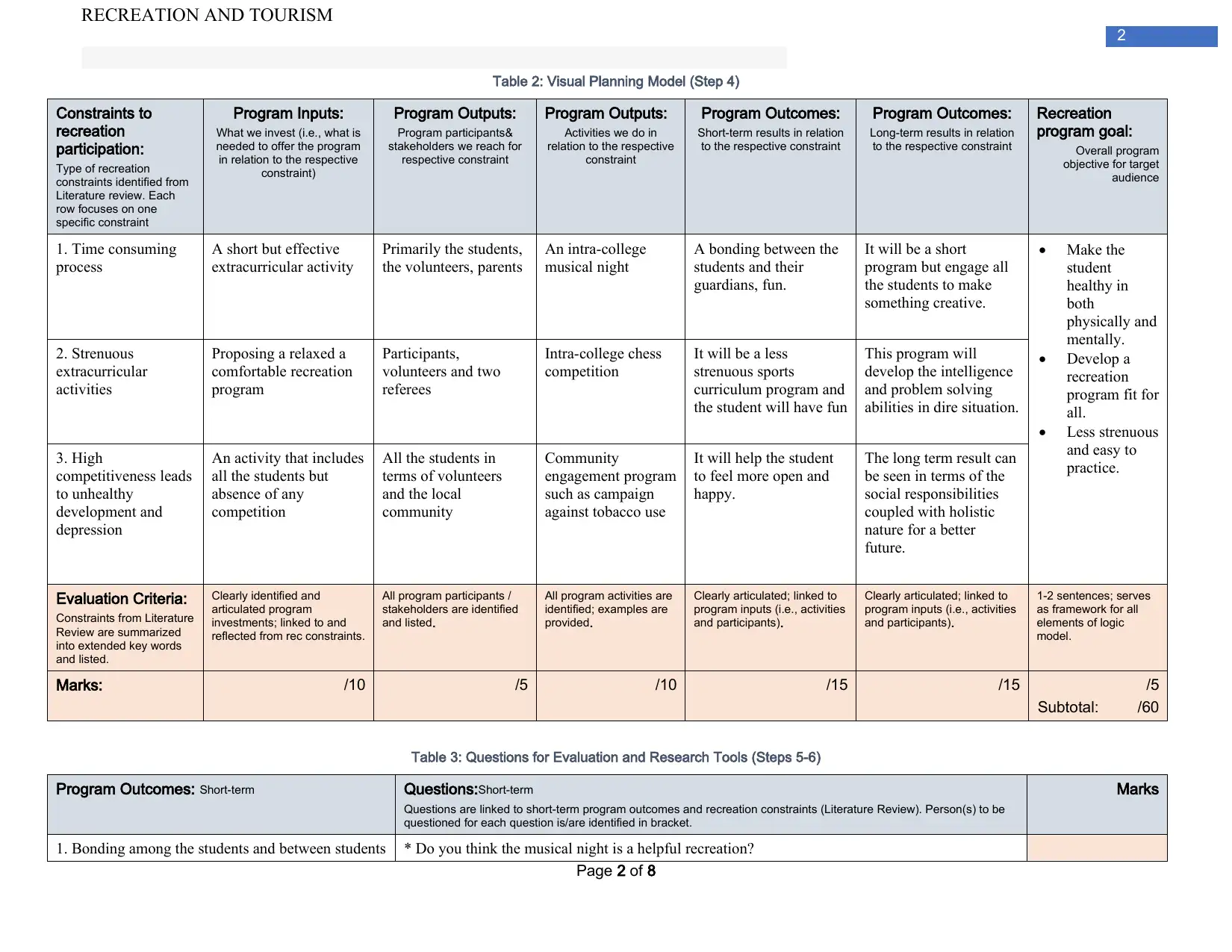
2
RECREATION AND TOURISM
Table 2: Visual Planning Model (Step 4)
Constraints to
recreation
participation:
Type of recreation
constraints identified from
Literature review. Each
row focuses on one
specific constraint
Program Inputs:
What we invest (i.e., what is
needed to offer the program
in relation to the respective
constraint)
Program Outputs:
Program participants&
stakeholders we reach for
respective constraint
Program Outputs:
Activities we do in
relation to the respective
constraint
Program Outcomes:
Short-term results in relation
to the respective constraint
Program Outcomes:
Long-term results in relation
to the respective constraint
Recreation
program goal:
Overall program
objective for target
audience
1. Time consuming
process
A short but effective
extracurricular activity
Primarily the students,
the volunteers, parents
An intra-college
musical night
A bonding between the
students and their
guardians, fun.
It will be a short
program but engage all
the students to make
something creative.
Make the
student
healthy in
both
physically and
mentally.
Develop a
recreation
program fit for
all.
Less strenuous
and easy to
practice.
2. Strenuous
extracurricular
activities
Proposing a relaxed a
comfortable recreation
program
Participants,
volunteers and two
referees
Intra-college chess
competition
It will be a less
strenuous sports
curriculum program and
the student will have fun
This program will
develop the intelligence
and problem solving
abilities in dire situation.
3. High
competitiveness leads
to unhealthy
development and
depression
An activity that includes
all the students but
absence of any
competition
All the students in
terms of volunteers
and the local
community
Community
engagement program
such as campaign
against tobacco use
It will help the student
to feel more open and
happy.
The long term result can
be seen in terms of the
social responsibilities
coupled with holistic
nature for a better
future.
Evaluation Criteria:
Constraints from Literature
Review are summarized
into extended key words
and listed.
Clearly identified and
articulated program
investments; linked to and
reflected from rec constraints.
All program participants /
stakeholders are identified
and listed.
All program activities are
identified; examples are
provided.
Clearly articulated; linked to
program inputs (i.e., activities
and participants).
Clearly articulated; linked to
program inputs (i.e., activities
and participants).
1-2 sentences; serves
as framework for all
elements of logic
model.
Marks: /10 /5 /10 /15 /15 /5
Subtotal: /60
Table 3: Questions for Evaluation and Research Tools (Steps 5-6)
Program Outcomes: Short-term Questions:Short-term
Questions are linked to short-term program outcomes and recreation constraints (Literature Review). Person(s) to be
questioned for each question is/are identified in bracket.
Marks
1. Bonding among the students and between students * Do you think the musical night is a helpful recreation?
Page 2 of 8
RECREATION AND TOURISM
Table 2: Visual Planning Model (Step 4)
Constraints to
recreation
participation:
Type of recreation
constraints identified from
Literature review. Each
row focuses on one
specific constraint
Program Inputs:
What we invest (i.e., what is
needed to offer the program
in relation to the respective
constraint)
Program Outputs:
Program participants&
stakeholders we reach for
respective constraint
Program Outputs:
Activities we do in
relation to the respective
constraint
Program Outcomes:
Short-term results in relation
to the respective constraint
Program Outcomes:
Long-term results in relation
to the respective constraint
Recreation
program goal:
Overall program
objective for target
audience
1. Time consuming
process
A short but effective
extracurricular activity
Primarily the students,
the volunteers, parents
An intra-college
musical night
A bonding between the
students and their
guardians, fun.
It will be a short
program but engage all
the students to make
something creative.
Make the
student
healthy in
both
physically and
mentally.
Develop a
recreation
program fit for
all.
Less strenuous
and easy to
practice.
2. Strenuous
extracurricular
activities
Proposing a relaxed a
comfortable recreation
program
Participants,
volunteers and two
referees
Intra-college chess
competition
It will be a less
strenuous sports
curriculum program and
the student will have fun
This program will
develop the intelligence
and problem solving
abilities in dire situation.
3. High
competitiveness leads
to unhealthy
development and
depression
An activity that includes
all the students but
absence of any
competition
All the students in
terms of volunteers
and the local
community
Community
engagement program
such as campaign
against tobacco use
It will help the student
to feel more open and
happy.
The long term result can
be seen in terms of the
social responsibilities
coupled with holistic
nature for a better
future.
Evaluation Criteria:
Constraints from Literature
Review are summarized
into extended key words
and listed.
Clearly identified and
articulated program
investments; linked to and
reflected from rec constraints.
All program participants /
stakeholders are identified
and listed.
All program activities are
identified; examples are
provided.
Clearly articulated; linked to
program inputs (i.e., activities
and participants).
Clearly articulated; linked to
program inputs (i.e., activities
and participants).
1-2 sentences; serves
as framework for all
elements of logic
model.
Marks: /10 /5 /10 /15 /15 /5
Subtotal: /60
Table 3: Questions for Evaluation and Research Tools (Steps 5-6)
Program Outcomes: Short-term Questions:Short-term
Questions are linked to short-term program outcomes and recreation constraints (Literature Review). Person(s) to be
questioned for each question is/are identified in bracket.
Marks
1. Bonding among the students and between students * Do you think the musical night is a helpful recreation?
Page 2 of 8
⊘ This is a preview!⊘
Do you want full access?
Subscribe today to unlock all pages.

Trusted by 1+ million students worldwide
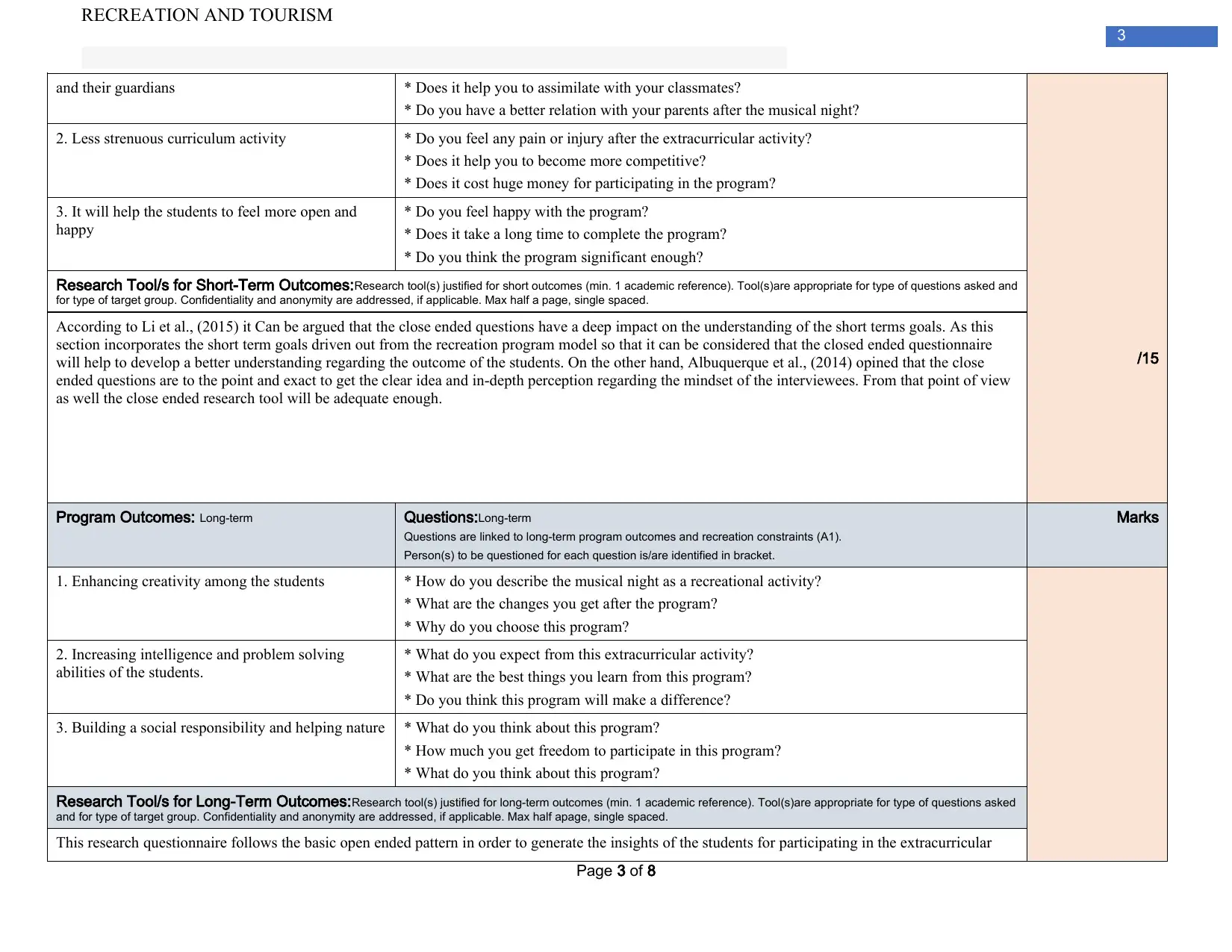
3
RECREATION AND TOURISM
and their guardians * Does it help you to assimilate with your classmates?
* Do you have a better relation with your parents after the musical night?
/15
2. Less strenuous curriculum activity * Do you feel any pain or injury after the extracurricular activity?
* Does it help you to become more competitive?
* Does it cost huge money for participating in the program?
3. It will help the students to feel more open and
happy
* Do you feel happy with the program?
* Does it take a long time to complete the program?
* Do you think the program significant enough?
Research Tool/s for Short-Term Outcomes:Research tool(s) justified for short outcomes (min. 1 academic reference). Tool(s)are appropriate for type of questions asked and
for type of target group. Confidentiality and anonymity are addressed, if applicable. Max half a page, single spaced.
According to Li et al., (2015) it Can be argued that the close ended questions have a deep impact on the understanding of the short terms goals. As this
section incorporates the short term goals driven out from the recreation program model so that it can be considered that the closed ended questionnaire
will help to develop a better understanding regarding the outcome of the students. On the other hand, Albuquerque et al., (2014) opined that the close
ended questions are to the point and exact to get the clear idea and in-depth perception regarding the mindset of the interviewees. From that point of view
as well the close ended research tool will be adequate enough.
Program Outcomes: Long-term Questions:Long-term
Questions are linked to long-term program outcomes and recreation constraints (A1).
Person(s) to be questioned for each question is/are identified in bracket.
Marks
1. Enhancing creativity among the students * How do you describe the musical night as a recreational activity?
* What are the changes you get after the program?
* Why do you choose this program?
2. Increasing intelligence and problem solving
abilities of the students.
* What do you expect from this extracurricular activity?
* What are the best things you learn from this program?
* Do you think this program will make a difference?
3. Building a social responsibility and helping nature * What do you think about this program?
* How much you get freedom to participate in this program?
* What do you think about this program?
Research Tool/s for Long-Term Outcomes:Research tool(s) justified for long-term outcomes (min. 1 academic reference). Tool(s)are appropriate for type of questions asked
and for type of target group. Confidentiality and anonymity are addressed, if applicable. Max half apage, single spaced.
This research questionnaire follows the basic open ended pattern in order to generate the insights of the students for participating in the extracurricular
Page 3 of 8
RECREATION AND TOURISM
and their guardians * Does it help you to assimilate with your classmates?
* Do you have a better relation with your parents after the musical night?
/15
2. Less strenuous curriculum activity * Do you feel any pain or injury after the extracurricular activity?
* Does it help you to become more competitive?
* Does it cost huge money for participating in the program?
3. It will help the students to feel more open and
happy
* Do you feel happy with the program?
* Does it take a long time to complete the program?
* Do you think the program significant enough?
Research Tool/s for Short-Term Outcomes:Research tool(s) justified for short outcomes (min. 1 academic reference). Tool(s)are appropriate for type of questions asked and
for type of target group. Confidentiality and anonymity are addressed, if applicable. Max half a page, single spaced.
According to Li et al., (2015) it Can be argued that the close ended questions have a deep impact on the understanding of the short terms goals. As this
section incorporates the short term goals driven out from the recreation program model so that it can be considered that the closed ended questionnaire
will help to develop a better understanding regarding the outcome of the students. On the other hand, Albuquerque et al., (2014) opined that the close
ended questions are to the point and exact to get the clear idea and in-depth perception regarding the mindset of the interviewees. From that point of view
as well the close ended research tool will be adequate enough.
Program Outcomes: Long-term Questions:Long-term
Questions are linked to long-term program outcomes and recreation constraints (A1).
Person(s) to be questioned for each question is/are identified in bracket.
Marks
1. Enhancing creativity among the students * How do you describe the musical night as a recreational activity?
* What are the changes you get after the program?
* Why do you choose this program?
2. Increasing intelligence and problem solving
abilities of the students.
* What do you expect from this extracurricular activity?
* What are the best things you learn from this program?
* Do you think this program will make a difference?
3. Building a social responsibility and helping nature * What do you think about this program?
* How much you get freedom to participate in this program?
* What do you think about this program?
Research Tool/s for Long-Term Outcomes:Research tool(s) justified for long-term outcomes (min. 1 academic reference). Tool(s)are appropriate for type of questions asked
and for type of target group. Confidentiality and anonymity are addressed, if applicable. Max half apage, single spaced.
This research questionnaire follows the basic open ended pattern in order to generate the insights of the students for participating in the extracurricular
Page 3 of 8
Paraphrase This Document
Need a fresh take? Get an instant paraphrase of this document with our AI Paraphraser
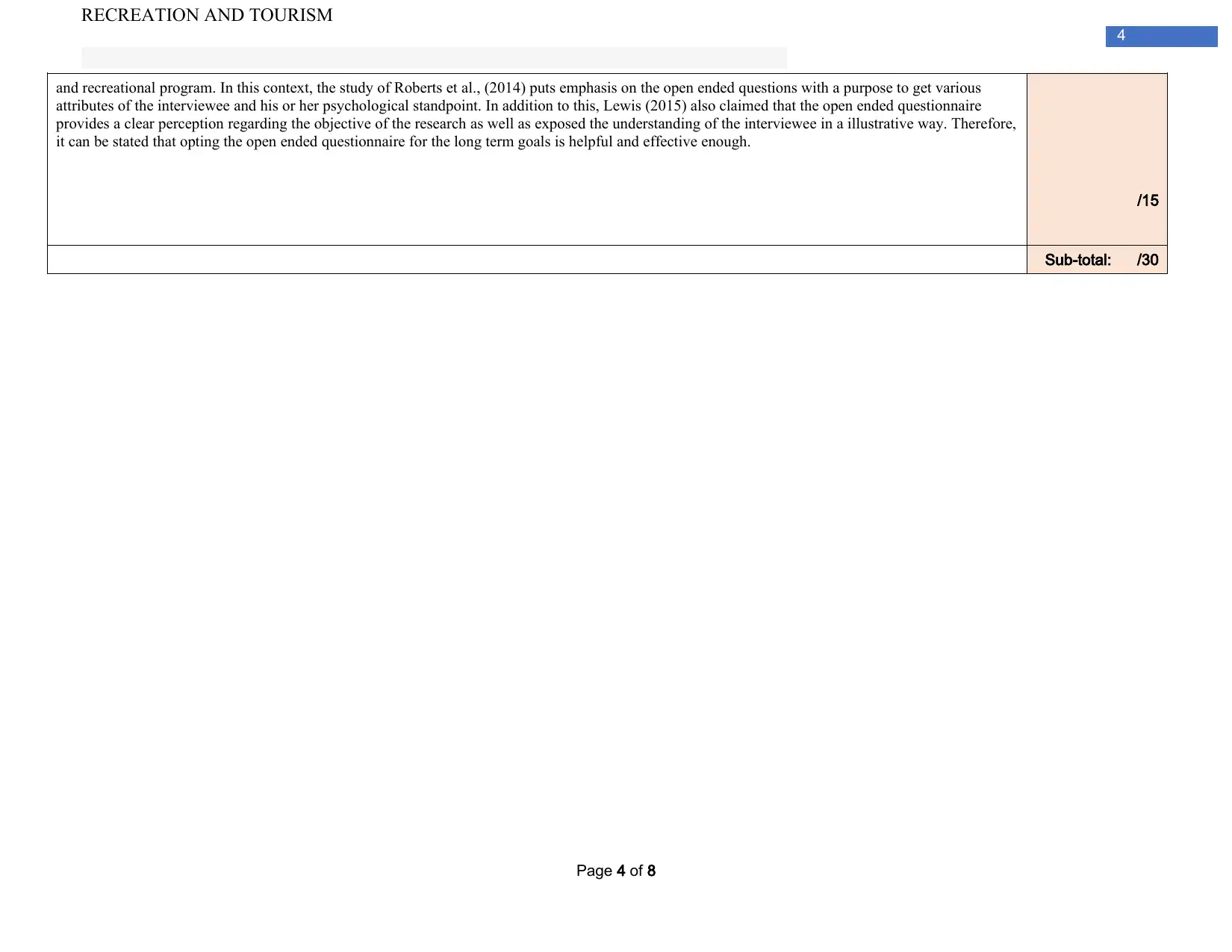
4
RECREATION AND TOURISM
and recreational program. In this context, the study of Roberts et al., (2014) puts emphasis on the open ended questions with a purpose to get various
attributes of the interviewee and his or her psychological standpoint. In addition to this, Lewis (2015) also claimed that the open ended questionnaire
provides a clear perception regarding the objective of the research as well as exposed the understanding of the interviewee in a illustrative way. Therefore,
it can be stated that opting the open ended questionnaire for the long term goals is helpful and effective enough.
/15
Sub-total: /30
Page 4 of 8
RECREATION AND TOURISM
and recreational program. In this context, the study of Roberts et al., (2014) puts emphasis on the open ended questions with a purpose to get various
attributes of the interviewee and his or her psychological standpoint. In addition to this, Lewis (2015) also claimed that the open ended questionnaire
provides a clear perception regarding the objective of the research as well as exposed the understanding of the interviewee in a illustrative way. Therefore,
it can be stated that opting the open ended questionnaire for the long term goals is helpful and effective enough.
/15
Sub-total: /30
Page 4 of 8
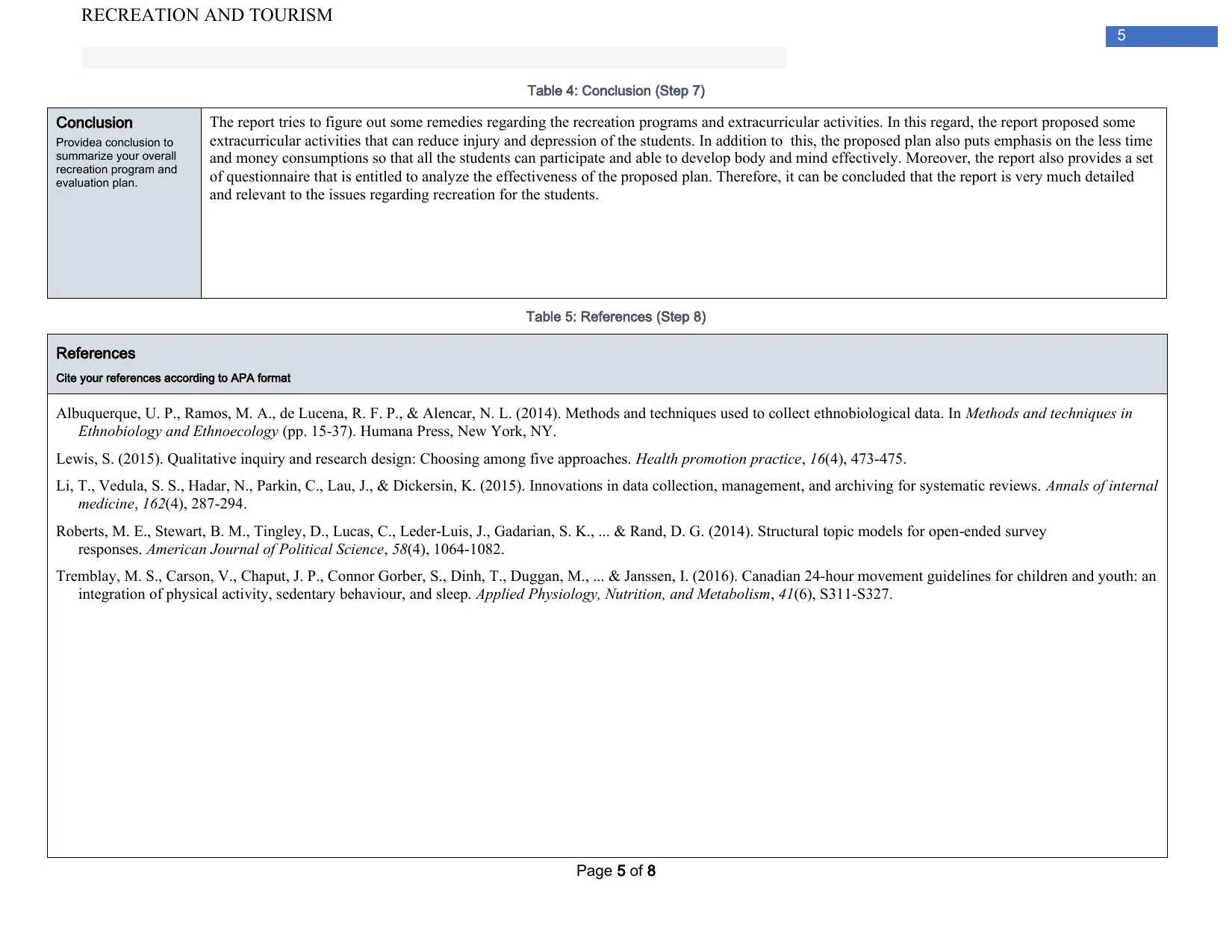
5
RECREATION AND TOURISM
Table 4: Conclusion (Step 7)
Conclusion
Providea conclusion to
summarize your overall
recreation program and
evaluation plan.
The report tries to figure out some remedies regarding the recreation programs and extracurricular activities. In this regard, the report proposed some
extracurricular activities that can reduce injury and depression of the students. In addition to this, the proposed plan also puts emphasis on the less time
and money consumptions so that all the students can participate and able to develop body and mind effectively. Moreover, the report also provides a set
of questionnaire that is entitled to analyze the effectiveness of the proposed plan. Therefore, it can be concluded that the report is very much detailed
and relevant to the issues regarding recreation for the students.
Table 5: References (Step 8)
References
Cite your references according to APA format
Albuquerque, U. P., Ramos, M. A., de Lucena, R. F. P., & Alencar, N. L. (2014). Methods and techniques used to collect ethnobiological data. In Methods and techniques in
Ethnobiology and Ethnoecology (pp. 15-37). Humana Press, New York, NY.
Lewis, S. (2015). Qualitative inquiry and research design: Choosing among five approaches. Health promotion practice, 16(4), 473-475.
Li, T., Vedula, S. S., Hadar, N., Parkin, C., Lau, J., & Dickersin, K. (2015). Innovations in data collection, management, and archiving for systematic reviews. Annals of internal
medicine, 162(4), 287-294.
Roberts, M. E., Stewart, B. M., Tingley, D., Lucas, C., Leder Luis, J., Gadarian, S. K., ... & Rand, D. G. (2014). Structural topic models for open ended survey‐ ‐
responses. American Journal of Political Science, 58(4), 1064-1082.
Tremblay, M. S., Carson, V., Chaput, J. P., Connor Gorber, S., Dinh, T., Duggan, M., ... & Janssen, I. (2016). Canadian 24-hour movement guidelines for children and youth: an
integration of physical activity, sedentary behaviour, and sleep. Applied Physiology, Nutrition, and Metabolism, 41(6), S311-S327.
Page 5 of 8
RECREATION AND TOURISM
Table 4: Conclusion (Step 7)
Conclusion
Providea conclusion to
summarize your overall
recreation program and
evaluation plan.
The report tries to figure out some remedies regarding the recreation programs and extracurricular activities. In this regard, the report proposed some
extracurricular activities that can reduce injury and depression of the students. In addition to this, the proposed plan also puts emphasis on the less time
and money consumptions so that all the students can participate and able to develop body and mind effectively. Moreover, the report also provides a set
of questionnaire that is entitled to analyze the effectiveness of the proposed plan. Therefore, it can be concluded that the report is very much detailed
and relevant to the issues regarding recreation for the students.
Table 5: References (Step 8)
References
Cite your references according to APA format
Albuquerque, U. P., Ramos, M. A., de Lucena, R. F. P., & Alencar, N. L. (2014). Methods and techniques used to collect ethnobiological data. In Methods and techniques in
Ethnobiology and Ethnoecology (pp. 15-37). Humana Press, New York, NY.
Lewis, S. (2015). Qualitative inquiry and research design: Choosing among five approaches. Health promotion practice, 16(4), 473-475.
Li, T., Vedula, S. S., Hadar, N., Parkin, C., Lau, J., & Dickersin, K. (2015). Innovations in data collection, management, and archiving for systematic reviews. Annals of internal
medicine, 162(4), 287-294.
Roberts, M. E., Stewart, B. M., Tingley, D., Lucas, C., Leder Luis, J., Gadarian, S. K., ... & Rand, D. G. (2014). Structural topic models for open ended survey‐ ‐
responses. American Journal of Political Science, 58(4), 1064-1082.
Tremblay, M. S., Carson, V., Chaput, J. P., Connor Gorber, S., Dinh, T., Duggan, M., ... & Janssen, I. (2016). Canadian 24-hour movement guidelines for children and youth: an
integration of physical activity, sedentary behaviour, and sleep. Applied Physiology, Nutrition, and Metabolism, 41(6), S311-S327.
Page 5 of 8
⊘ This is a preview!⊘
Do you want full access?
Subscribe today to unlock all pages.

Trusted by 1+ million students worldwide
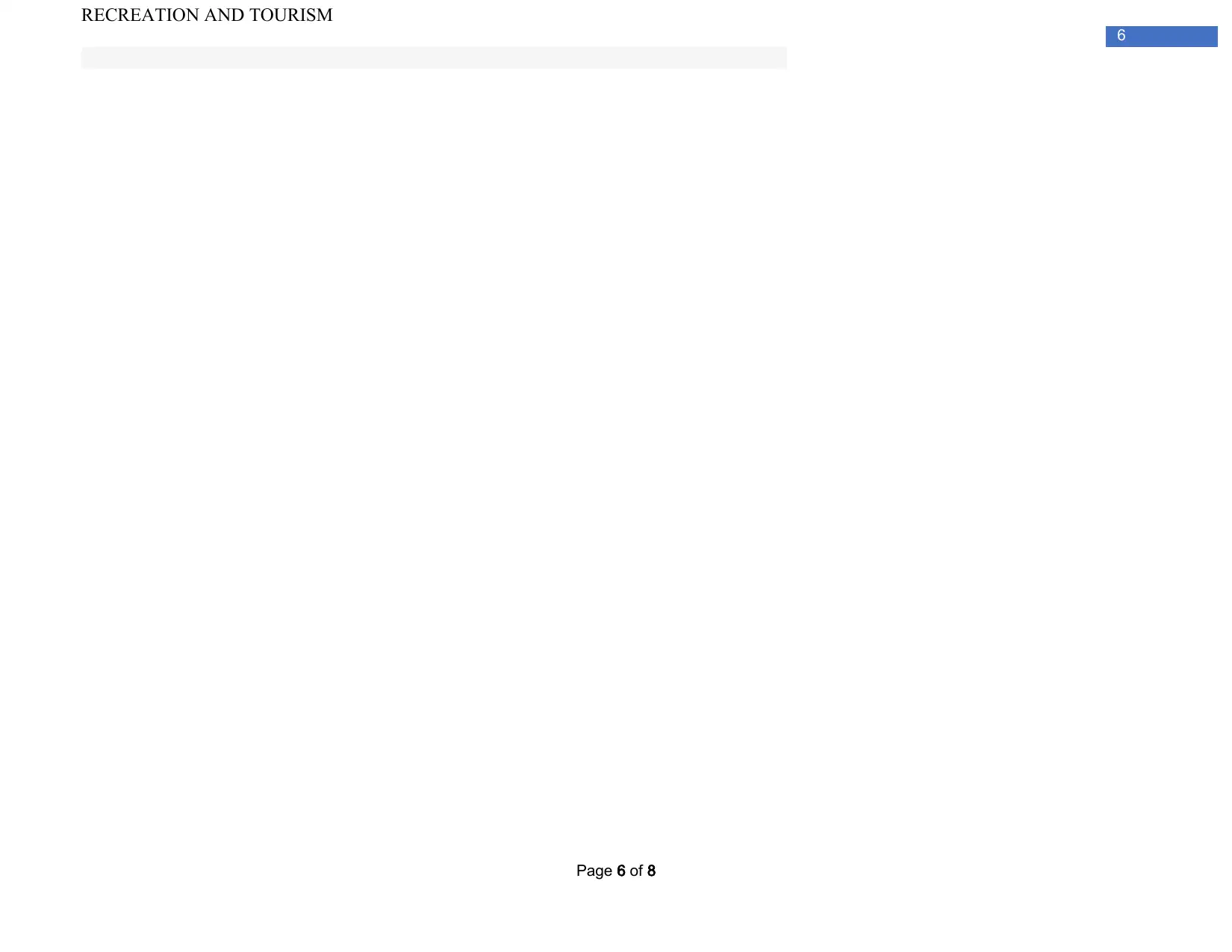
6
RECREATION AND TOURISM
Page 6 of 8
RECREATION AND TOURISM
Page 6 of 8
Paraphrase This Document
Need a fresh take? Get an instant paraphrase of this document with our AI Paraphraser
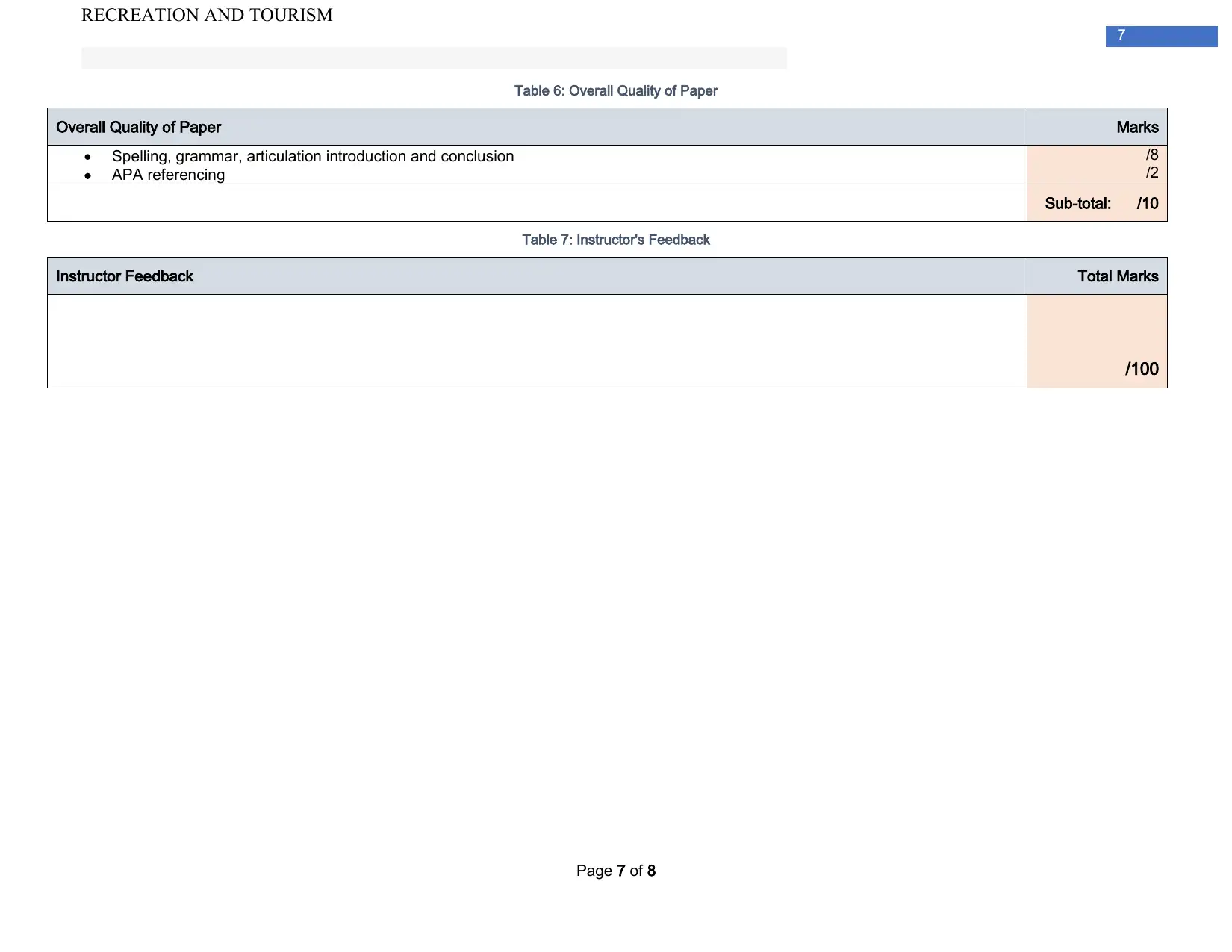
7
RECREATION AND TOURISM
Table 6: Overall Quality of Paper
Overall Quality of Paper Marks
Spelling, grammar, articulation introduction and conclusion
APA referencing
/8
/2
Sub-total: /10
Table 7: Instructor's Feedback
Instructor Feedback Total Marks
/100
Page 7 of 8
RECREATION AND TOURISM
Table 6: Overall Quality of Paper
Overall Quality of Paper Marks
Spelling, grammar, articulation introduction and conclusion
APA referencing
/8
/2
Sub-total: /10
Table 7: Instructor's Feedback
Instructor Feedback Total Marks
/100
Page 7 of 8
1 out of 8
Related Documents
Your All-in-One AI-Powered Toolkit for Academic Success.
+13062052269
info@desklib.com
Available 24*7 on WhatsApp / Email
![[object Object]](/_next/static/media/star-bottom.7253800d.svg)
Unlock your academic potential
Copyright © 2020–2025 A2Z Services. All Rights Reserved. Developed and managed by ZUCOL.





